
Ruben I,, also Roupen I or Rupen I, was the first lord of Armenian Cilicia. He declared the independence of Cilicia from the Byzantine Empire, thus formally founding the beginning of Armenian rule there. The Roupenian dynasty ruled Cilician Armenia until 1219.

Islam began to make inroads into the Armenian Plateau during the seventh century. Arab, and later Kurdish, tribes began to settle in Armenia following the first Arab invasions and played a considerable role in the political and social history of Armenia. With the Seljuk invasions of the eleventh and twelfth centuries, the Turkic element eventually superseded that of the Arab and Kurdish. With the establishment of the Iranian Safavid dynasty, Afsharid dynasty, Zand Dynasty and Qajar dynasty, Armenia became an integral part of the Shia world, while still maintaining a relatively independent Christian identity. The pressures brought upon the imposition of foreign rule by a succession of Muslim states forced many lead Armenians in Anatolia and what is today Armenia to convert to Islam and assimilate into the Muslim community. Many Armenians were also forced to convert to Islam, on the penalty of death, during the years of the Armenian Genocide.
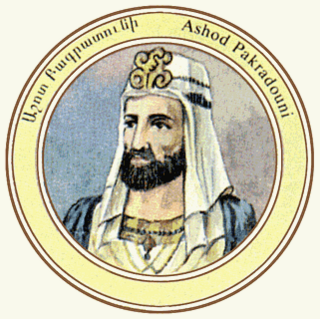
Ashot I was an Armenian king who oversaw the beginning of Armenia's second golden age. He was the son of Smbat VIII the Confessor and was a member of the Bagratuni Dynasty.

The Shaddadids were a Kurdish Sunni Muslim dynasty. who ruled in various parts of Armenia and Arran from 951 to 1199 AD. They were established in Dvin. Through their long tenure in Armenia, they often intermarried with the Bagratuni royal family of Armenia.
Gagik II was the last Armenian king of the Bagratuni dynasty. Known as Gagik II King of Ani he was enthroned as Gagik II and ruled for a brief period from 1042 to 1045 before the Bagratid dynasty rule collapsed in Armenia.
The early military history of Armenia is defined by the situation of the Armenian Highland between the Hellenistic states, and later the Byzantine Empire, in the west and the Persian Empire to the east. The Kingdom of Armenia had a series of repeated struggles for independence from Persia or Rome, followed by renewed conquests into either of the neighboring empires. The period after the Muslim conquests in the 7th century, up to the late 15th century, was mostly marked by domination by other empires, such as by the successive Arab Caliphates, the Seljuk Empire, the Ilkhanate, the Timurid Empire and the Ak Koyunlu and Kara Koyunlu, amongst others. Some periods of greater military independence were, intermittently, achieved under the Bagratids and, albeit located outside the Armenian Highlands, the Armenian Kingdom of Cilicia.

Ani is a ruined medieval Armenian city now situated in Turkey's province of Kars, next to the closed border with Armenia.
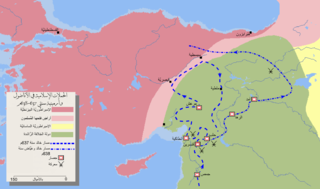
The Muslim conquest of parts of Armenia and Anatolia was a part of the Muslim conquests after the death of the Islamic prophet Muhammad in 632 CE. Persarmenia had fallen to the Arab Rashidun Caliphate by 645 CE. Byzantine Armenia was already conquered in 638–639.
The Shah-Armens, also known as Ahlatshahs, was a Turkoman Sunni Muslim Anatolian beylik founded after the Battle of Manzikert (1071) and centred in Ahlat on the northwestern shore of the Lake Van. This region comprised most of modern-day Bitlis and Van, and parts of Muş provinces.
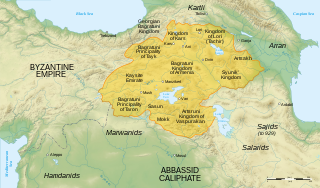
Bagratid Armenia was an independent Armenian state established by Ashot I Bagratuni of the Bagratuni dynasty in the early 880s following nearly two centuries of foreign domination of Greater Armenia under Arab Umayyad and Abbasid rule. With each of the two contemporary powers in the region—the Abbasids and Byzantines—too preoccupied to concentrate their forces in subjugating the region, and with the dissipation of several of the Armenian nakharar noble families, Ashot succeeded in asserting himself as the leading figure of a movement to dislodge the Arabs from Armenia.

Ashot III was a king of Armenia, ruling the medieval kingdom of Armenia from 952/53–77. Known as Ashot III the Merciful and acknowledged by foreign rulers as the Shahanshah of Mets Hayk', he moved his royal seat of residence to Ani and oversaw its development and of the kingdom as a whole. Armenia reached the height of its golden era during his reign and that of his sons and successors, Smbat II (977–89) and Gagik I (990–1020).

The Kaysite dynasty was a Muslim Arab dynasty that ruled an emirate centered in Manzikert from c. 860 until 964. Their state was the most powerful Arab amirate in Armenia after the collapse of the ostikanate of Arminiya in the late 9th century.
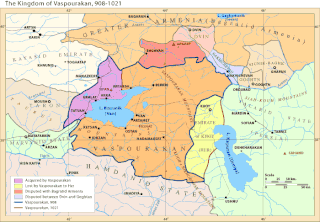
The Kingdom of Vaspurakan was a medieval Armenian kingdom centered on Lake Van, located in what is now eastern Turkey and northwestern Iran. It was named after Vaspurakan, a province of historic Greater Armenia. Ruled by the Artsruni dynasty, it competed and cooperated with the Bagratuni-ruled Kingdom of Armenia for a little over a century until its last king ceded the kingdom to the Byzantine Empire in 1021.

Zakarid Armenia was an Armenian principality between 1201 and 1360, ruled by the Zakarid-Mkhargrzeli dynasty. The city of Ani was the capital of the princedom. The Zakarids were vassals to the Bagrationi dynasty in Georgia, but frequently acted independently and at times titled themselves as kings. In 1236, they fell under the rule of the Mongol Empire. Their descendants continued to hold Ani until the 1330s, when they lost it to a succession of Turkish dynasties, including the Kara Koyunlu, who made Ani their capital.

Arab rule in Georgia, natively known as Araboba refers to the period in the History of Georgia when all or part of the country was under political domination of Muslim Arab rulers, from the first Arab incursions in the mid-7th century until the final defeat of the Emirate of Tbilisi at the hands of King David IV in 1122. Compared with other regions which endured Muslim conquests, Georgia's culture, and even political structure was not much affected by the Arab presence, as the people kept their faith, the nobles their fiefdoms, and the foreign rulers mostly insisted on the payment of tribute, which they could not always enforce. Still, repeated invasions and military campaigns by the Arabs devastated Georgia on many occasions, and the Caliphs retained suzerainty over large parts of the country and exerted influence over the internal power dynamics during most of the period.
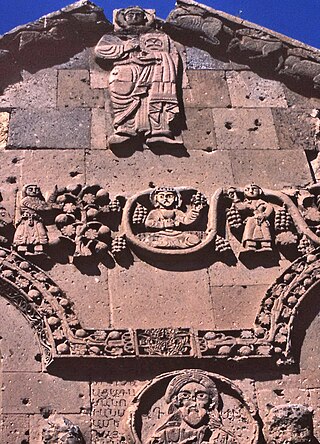
Gagik I Artsruni was an Armenian noble of the Artsruni dynasty who ruled over Vaspurakan in southern Armenia, first as prince of northwestern Vaspurakan and after that until his death as King of Vaspurakan, also claiming the title of King of Armenia.

The Bagratuni or Bagratid dynasty was an Armenian royal dynasty which ruled the medieval Kingdom of Armenia from c. 885 until 1045. Originating as vassals of the Kingdom of Armenia of antiquity, they rose to become the most prominent Armenian noble family during the period of Arab rule in Armenia, eventually establishing their own independent kingdom. Their domain included regions of Armenia such as Shirak, Bagrevand, Kogovit, Syunik, Lori, Vaspurakan, Vanand and Taron. Many historians, such as Cyril Toumanoff, Nicholas Adontz and Ronald Suny, consider them to be the progenitors of the Georgian royal Bagrationi dynasty.
The Bagratuni family tree describes the heritage of the Bagratuni family in Armenia and Georgia.














